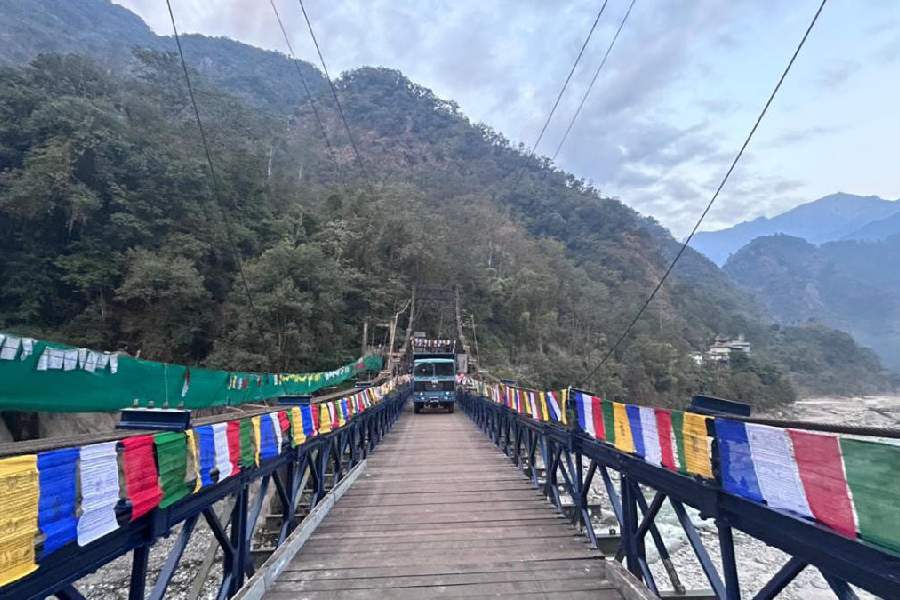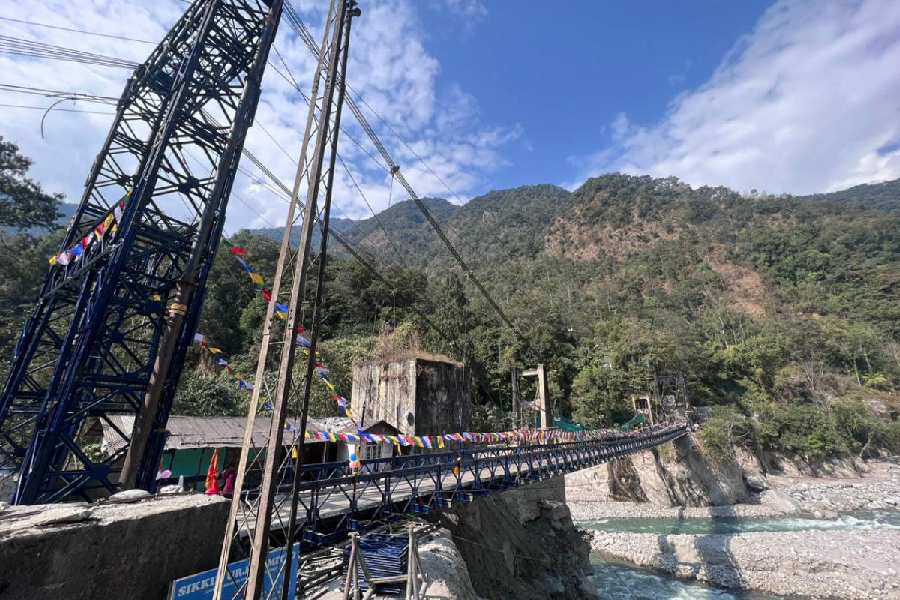
Sikkim bridge up within 3 months: Link restored to Dzongu near China border to help defence, tourism
Don't Miss
After the flash flood in the Teesta on October 4 last year, connectivity between parts of north Sikkim in Mangan district of the Himalayan state and the Indian mainland snapped as over a dozen bridges on the river were swept away in the district
 |
| The 400-foot-long Bailey suspension bridge inaugurated on the Teesta river at Sanklang in Mangan district in northern Sikkim on the occasion of Army Day on Monday.: The government of Sikkim |
Avijit Sinha, TT, Siliguri, 16.01.24 : The Border Roads Organisation (BRO), which functions under the defence ministry, has set a record of sorts by putting up a bridge over the Teesta river in Sikkim’s Mangan in less than three months.
The 400-foot-long Bailey bridge connects two parts of Sanklang and links the Dzongu region, which sources said was good news for both defence and tourism.
After the flash flood in the Teesta on October 4 last year, connectivity between parts of north Sikkim in Mangan district of the Himalayan state and the Indian mainland snapped as over a dozen bridges on the river were swept away in the district.
“So, the other part of the state, along the China border, got completely cut off.... This region has always been important for strategic reasons. Also, some daring tourists love to travel from Lachen to the Gurudongmar Lake at a height of 17,100 feet. Thousands of tourists also visit Dzongu, Lachung, Yumthang and Yumesamdong, which are close to the China border. Tourism in this region also got badly hit after the bridges were swept away,” said Raj Basu, a veteran in the tourism industry in east and northeast India.
After the disaster, the BRO and the army took up the task of installing Bailey bridges at Sanklang, Chungthang and Zema within two months.
“These bridges were necessary to re-establish the logistic supply chain for armed forces and residents of Chungthang, Lachung and Lachen and the upper reaches of north Sikkim near the China border,” said a source.
Apart from the bridges, the BRO, along with the state government and other agencies, also took up the task of restoring roads. Nearly 25km of roads were washed away by the Teesta in the district in the wake of the October flood.
After the disaster, the state announced that tourist destinations in north Sikkim would stay closed.
“This badly impacted tourism as Lachen, Gurudongmar Lake, Lachung and Dzongu are some of the finest tourist spots in Sikkim. Many tourists in early October cancelled their trips planned for during Durga Puja and Diwali,” said Samrat Sanyal, general secretary of Himalayan Hospitality and Tourism Development Network.
Lachen was cut off from the rest of the state till November 30 as a bridge was washed away. Choppers provided people their basic supplies. “Army engineers installed a Bailey bridge, but the area is still closed to tourists for restoration work,” said an official of the tourism and civil aviation department of Sikkim.
On December 1, the state announced that tourists could visit Lachung through a detour.
“The bridge which was opened on Monday connects Dzongu. To visit Lachung, one has to take the Dzongu–Shipgyer route now. The bridge will help tourists,” the official added.
North Sikkim is a tourist challenge as the roads are not good. There are several narrow stretches and bends. During monsoons, frequent landslides disrupt traffic.
Sources said after the disaster, Bailey bridges were laid at Sangklang, Chungthang and Zema. However, as bridges at Sanklang and Zema were set up close to the riverbed, they will be dismantled before monsoon.
“Thus, the BRO decided on the 400-foot-long suspension bridge, which rains won’t affect. It was built within three months, which is a record,” said a source.
He added: “Armed forces can use the bridge too, to reach Lachen via Chungthang.”
Owing to its proximity with China, Sikkim has been a strategic area of importance for India, pointed out defence experts.
In 1967, troops of both countries clashed at Sikkim’s Nathu-la. In 2017, there was a military standoff at Doklam, an area at the tri-junction of India, China and Bhutan, close to Sikkim.
“From the strategic point of view, it is vital to restore road links in north Sikkim. The new bridge will ensure connectivity the year for various areas of Sikkim, including border ones,” said an ex-serviceman.



0 Response to "Sikkim bridge up within 3 months: Link restored to Dzongu near China border to help defence, tourism"
Post a Comment
Disclaimer Note:
The views expressed in the articles published here are solely those of the author and do not necessarily reflect the official policy, position, or perspective of Kalimpong News or KalimNews. Kalimpong News and KalimNews disclaim all liability for the published or posted articles, news, and information and assume no responsibility for the accuracy or validity of the content.
Kalimpong News is a non-profit online news platform managed by KalimNews and operated under the Kalimpong Press Club.
Comment Policy:
We encourage respectful and constructive discussions. Please ensure decency while commenting and register with your email ID to participate.
Note: only a member of this blog may post a comment.